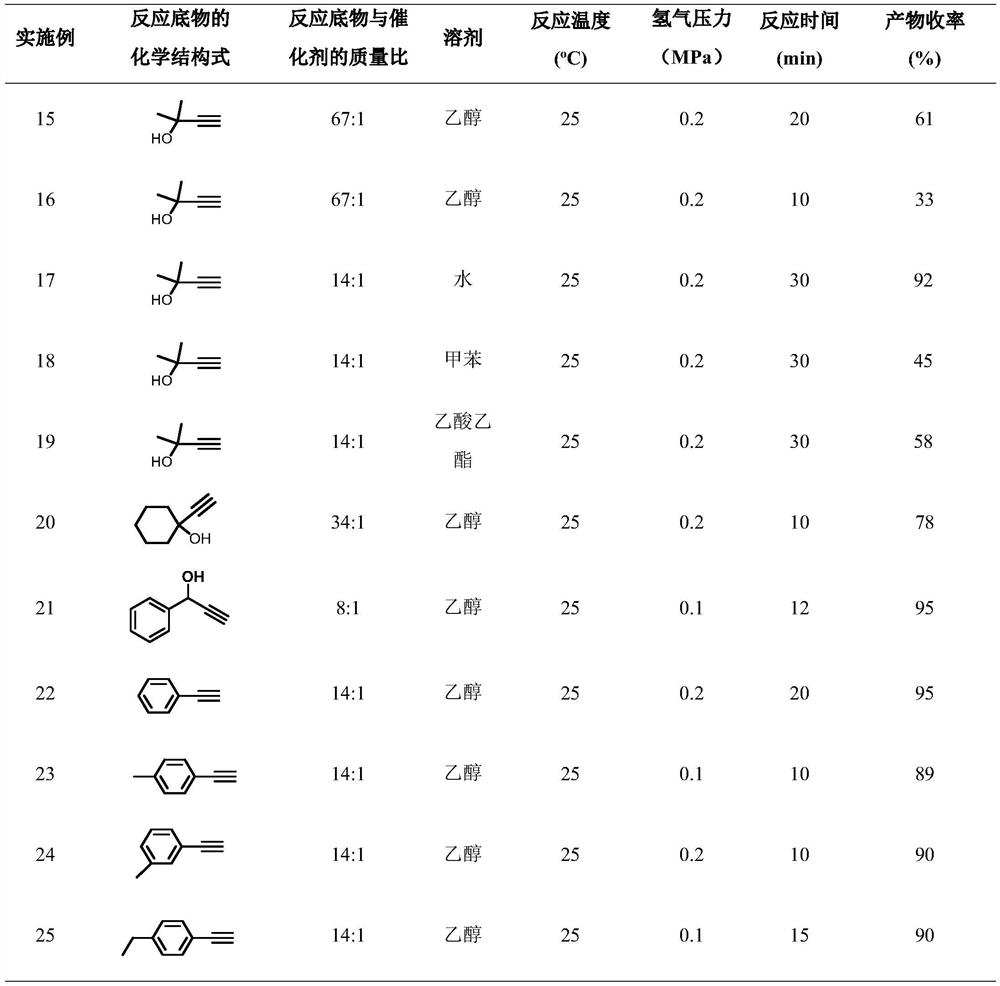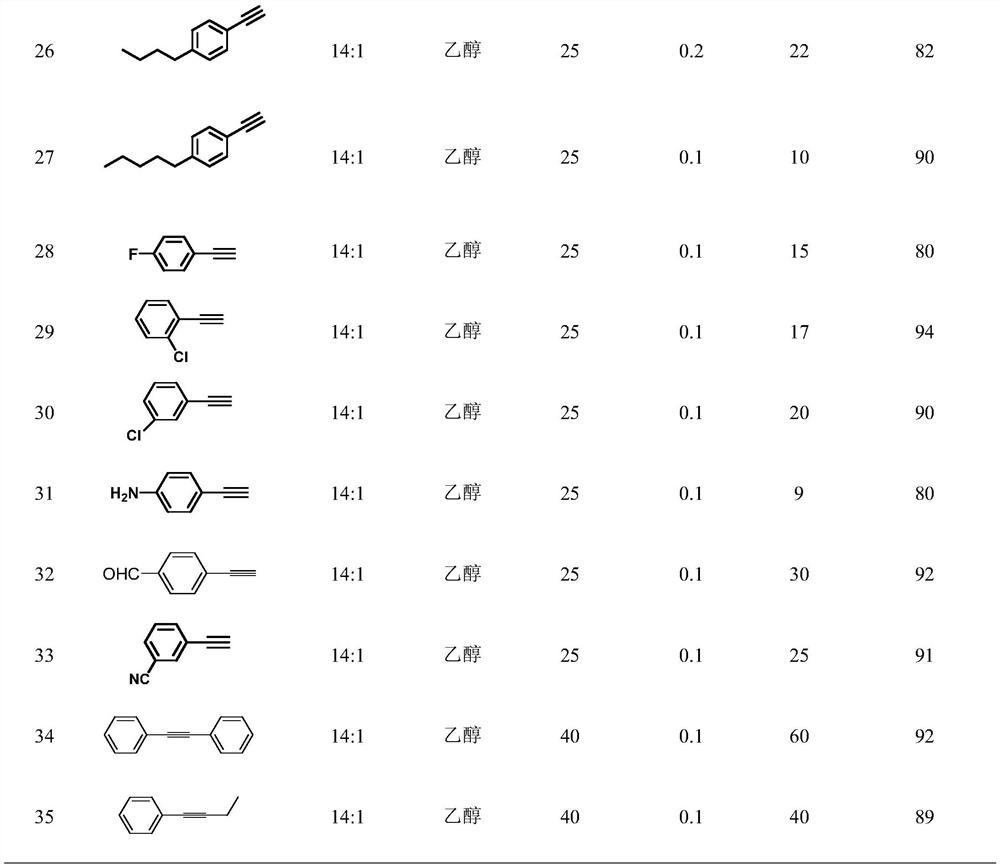A kind of heterogeneous catalyst for the selective hydrogenation reaction of alkynes and its application
A technology of heterogeneous catalysts and acetylene compounds, which is applied in the preparation of carbon compound catalysts, metal/metal oxide/metal hydroxide catalysts, organic compounds, etc., can solve the problem of low reaction selectivity, improved catalytic selectivity, Limit the application of catalysts and other problems, and achieve the effects of good dispersion, simple preparation method and low production cost
- Summary
- Abstract
- Description
- Claims
- Application Information
AI Technical Summary
Problems solved by technology
Method used
Image
Examples
Embodiment 1
[0023] Embodiment 1 is based on TiO 2-x and porous carbon (TiO 2-x @C) Pd-loaded heterogeneous catalysts
[0024] In a 100ml beaker, add 0.5g cellulose (artificial synthetic cellulose, particle size 65μm, purchased from McLean Reagent Company) and 50mL deionized water, stir to dissolve and then add TiO 2 (B) 0.1g, stir until a homogeneous mixture. Heat and stir until the deionized water in the beaker is completely volatilized to obtain a solid mixture. The solid obtained by this method can closely and uniformly combine the titanium oxide and the porous carbon after later calcination. The solid mixture was heated to 650°C in a nitrogen furnace and calcined for 1 hour to obtain TiO with a composition of 40wt%. 2-x (02 Aqueous solution (PdCl 2 The concentration of the aqueous solution is 10mg / mL), after ultrasonication for 10min, add 5mL of freshly prepared sodium borohydride aqueous solution to continue ultrasonication (the concentration of the sodium borohydride aqueous sol...
Embodiment 2
[0025] Embodiment 2 is based on TiO 2-x and porous carbon (TiO 2-x @C) Pd-loaded heterogeneous catalysts
[0026] Add 0.5g D-glucose (purchased from Sigma Reagent Company) and 50mL deionized water into a 100ml beaker, stir to dissolve and then add TiO 2 (B) 0.2g, stir until a homogeneous mixture. Heat and stir until the deionized water in the beaker is completely volatilized to obtain a solid mixture. After the solid mixture is programmed to heat up to 650° C. and calcined for 1 h in a nitrogen furnace, a TiO with a composition of 60 wt % is obtained. 2-x (02 Aqueous solution (PdCl 2 The concentration of the aqueous solution is 10mg / mL), after ultrasonication for 10min, add 5mL of freshly prepared sodium borohydride aqueous solution to continue ultrasonication (the concentration of the sodium borohydride aqueous solution is 1mg / mL), the Pd 2+ Reduced to simple Pd, filtered with suction, washed the filter residue with water for many times, and dried to obtain TiO 2-x @C su...
Embodiment 3
[0027] Embodiment 3 is based on TiO 2-x and porous carbon (TiO 2-x @C) Pd-loaded heterogeneous catalysts
[0028] In a 100ml beaker, add 0.5g cellulose (artificial synthetic cellulose, particle size 65μm, purchased from McLean Reagent Company), 50mL deionized water, stir to dissolve and then add TiO 2 (B) 0.3g, stir until a homogeneous mixture. Heat and stir until the deionized water in the beaker is completely volatilized to obtain a solid mixture. After the solid mixture is programmed to heat up to 650°C in a nitrogen furnace and calcined for 1 hour, a TiO with a composition of 70wt% is obtained. 2-x (02 Aqueous solution (PdCl 2 The concentration of the aqueous solution is 10mg / mL), after ultrasonication for 10min, add 1mL of freshly prepared sodium borohydride aqueous solution and continue ultrasonication (the concentration of the sodium borohydride aqueous solution is 2mg / mL), the Pd 2+ Reduced to simple Pd, filtered with suction, washed the filter residue with water f...
PUM
| Property | Measurement | Unit |
|---|---|---|
| particle diameter | aaaaa | aaaaa |
| diameter | aaaaa | aaaaa |
| particle size | aaaaa | aaaaa |
Abstract
Description
Claims
Application Information
 Login to View More
Login to View More - R&D
- Intellectual Property
- Life Sciences
- Materials
- Tech Scout
- Unparalleled Data Quality
- Higher Quality Content
- 60% Fewer Hallucinations
Browse by: Latest US Patents, China's latest patents, Technical Efficacy Thesaurus, Application Domain, Technology Topic, Popular Technical Reports.
© 2025 PatSnap. All rights reserved.Legal|Privacy policy|Modern Slavery Act Transparency Statement|Sitemap|About US| Contact US: help@patsnap.com


